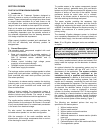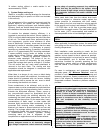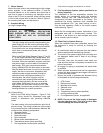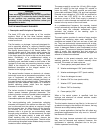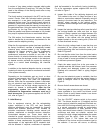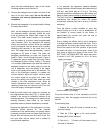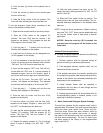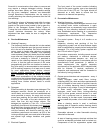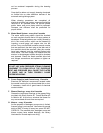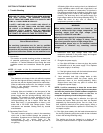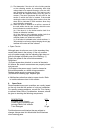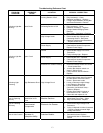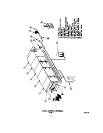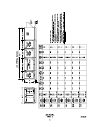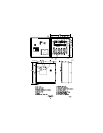
9
Some dirt is more tenacious than others to remove and
may require a stronger detergent solution. Average
settings have been factory set. Best possible settings
for any given installation, however, are determined
through experience. Determination can be made by
visually examining the collecting elements after the first
few washings.
To adjust the volume of detergent used within the given
time setting, loosen the knurled knob with an Allen
wrench on the control valve located in the by-pass line.
Refer to the Detergent System Outline, Figure 4.
Turning the knob clockwise increases the volume and
counter clockwise decreases the volume. When
adjustment has been made, be sure to retighten the
setscrew.
4. Routine Maintenance
A. Washing Frequency
The frequency that the collected dirt is to be washed
from the unit depends upon the type and amount of
dirt in the air to be cleaned. Dirt, which is greasy in
nature, tends to harden after collection and should
be washed away often. Likewise, units operating
under extremely heavy dirt loads should be washed
more often as a large build-up of collected material
will have a tendency to “blow-off” if permitted to
remain on the collecting elements for long periods
of time. In that the type and amount of dirt varies
geographically (and from one location to another in
any given area) it is recommended to start operation
with a washing frequency of at least once a week,
for most applications except kitchen exhaust.
Kitchen exhaust applications should be washed
daily. Schedules may then be altered as needed
after visual examinations of the collected material
contained on the ionizing-collecting cells. Also, daily
washing is not unusual for units operating on heavy
welding fume, kitchen exhaust hoods or similar
applications.
B. Detergent
Effective washing is dependent upon detergent. The
detergent reservoir should be examined on a
routine basis; a minimum tank level established and
never permitted to empty. An empty tank not only
means poor washing, but can also be detrimental to
the pump. The inside of the tank should be kept
clean, free from dirt and foreign objects. The
detergent as supplied by Trion, Inc., is formulated
specifically for electronic air cleaners and should not
be diluted when charging the tank. If substitutes are
used, they must be approved by Trion, so as to not
void the warranty and should be safe for use in
ventilation systems and non-caustic, as 95% of the
ionizing-collecting cells are constructed of aluminum
and special high voltage insulation and gasket
seals.
C. Electrical Operation
The front panel of the control contains indicating
lights for the power supplies, one or two depending
on the size of the ATS unit. The lights should be
observed on a daily basis to ensure that the
electronic air cleaners are operating.
5. Preventative Maintenance
A. Washing frequency – as required.
The washing schedule and detergent reservoir level
as outlined under routine maintenance is again
referenced here as excessively large contaminant
buildup on the collecting elements invites down
time. Established routine washing is a preventative
maintenance requirement. The frequencies
suggested below should be altered if necessary.
B. Fire control system - Every 4 to 6 months or as
required.
Inspection, cleaning and servicing of the fire
extinguishing system and all listed exhaust hoods
shall be completed by properly trained and qualified
personnel. For a fire control system supplied with
the ATS unit refer to Figure 7.
All actuation components, including remote manual
pull stations, mechanical or electrical devices,
detectors, fire-actuated dampers, etc., shall be
checked for proper operation in accordance with the
manufacturers listed procedures. In addition to
these requirements, the specific inspection
requirements of the applicable NFPA standard shall
also be followed. If required, certificates of
inspection and maintenance shall be forwarded to
the authority having jurisdiction.
C. Grease removal devices and components – every 4
to 6 months
Hoods, impingers, metal mesh filters, ionizing-
collecting cell(s) fan, ducts and other appurtenances
shall be cleaned to bare metal at frequent intervals
prior to surfaces becoming heavily contaminated
with grease or oily sludge. It may be advantageous
to clean readily removable items, such as
impingers, metal mesh filters, ionizing-collecting
cell(s) or other grease removal devices in a soak
tank, with a pressure hose or pressure cleaner.
After cleaning to the bare metal, components shall
not be coated with powder, oils or other substance.
When a cleaning service is used, a certificate
showing date of inspection and/or cleaning should
be maintained on the premises. Areas not cleaned
will be noted.
Flammable solvents or other flammable cleaning
aids shall not be used.
At start of cleaning process, electrical switches that
could be accidentally activated shall be locked out.
Components of the fire suppression system shall



